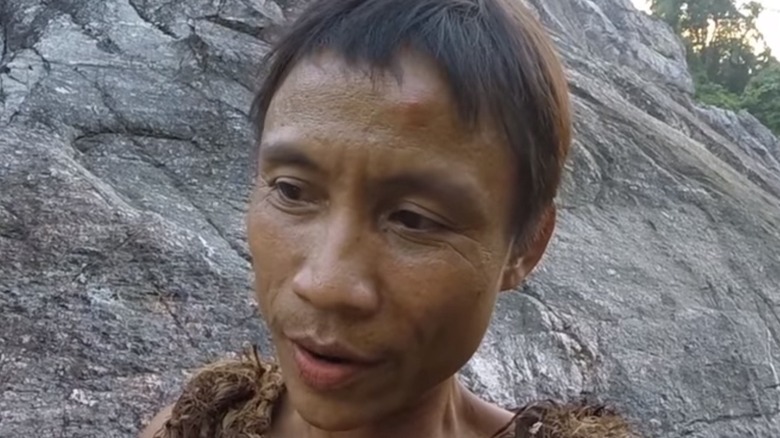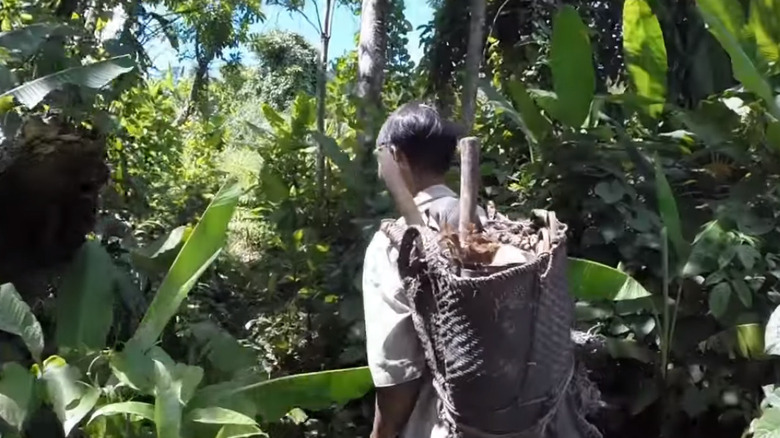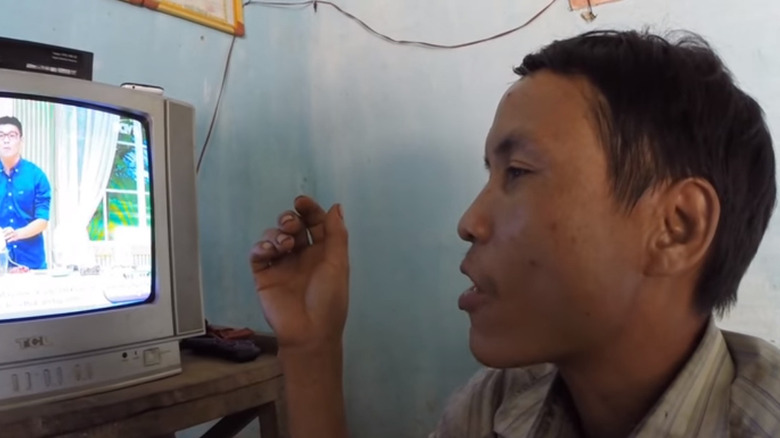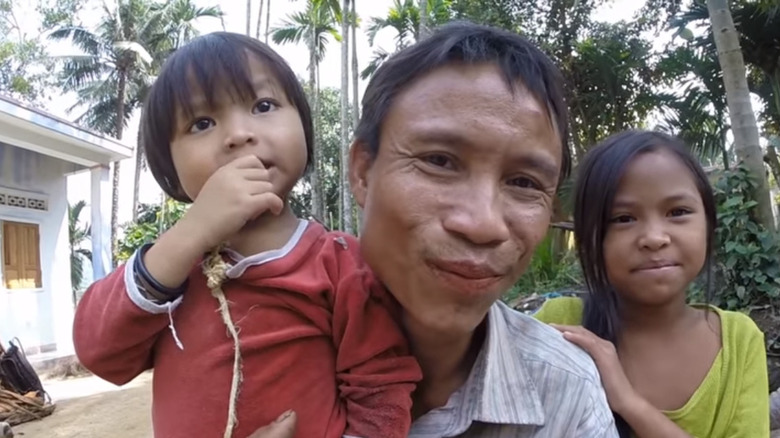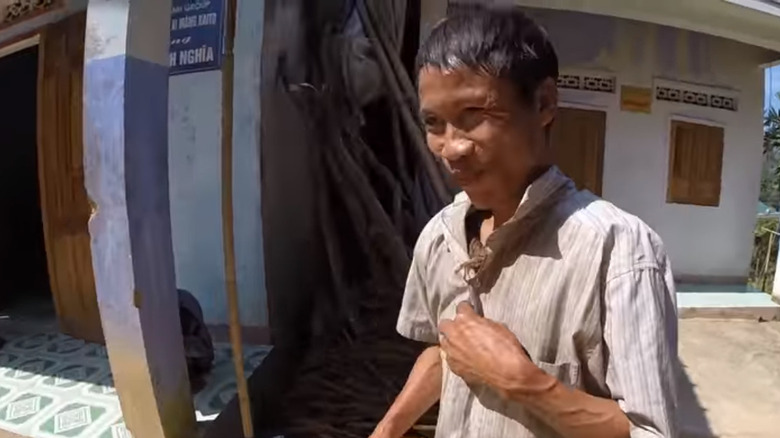The Tragic Death Of Vietnam's Real-Life Tarzan
For over 100 years, we've seen Tarzan swinging through the vines of print and film. His rugged demeanor, not quite compatible with the modern world, was instilled in him by the apes who raised him while the character had a sense of charm capable of wooing the "civilized" Jane that could've only been cultivated in a romantic, fictional jungle, and it made him an instant hit. According to Britannica, Tarzan was first written to life by author Edgar Rice Burroughs in 1912. By 1914, he'd become the focal point of a novel series that sold more than 25 million copies and gave way to a franchise now known intimately by generation upon generation. Even if you don't happen to know the old stories or the black-and-white films, there's a good chance you've caught at least one of the modern animated movies or, dare we say, the Brendon Fraser parody "George of the Jungle."
It's always interesting to see a literary character like Tarzan paralleled by a tangible person in the real world. In the case of this vine-swinging protagonist, there was, until recently, a man living in the jungles of Vietnam for nearly half a century who truly earned his moniker. The story of Ho Van Lang is an interesting if not unfortunate one, and like any good story, the lives of real people must also come to an end.
A real-life Tarzan living 40 years in the jungle
Edgar Rice Burroughs' creation came from aristocratic stock and was only abandoned to the jungles of Africa after his family was marooned on the continent in an accident, as The Telegraph notes, but Ho Van Lang's story began a little differently. Lang's father had purposefully taken him to the jungle to escape the fighting that had killed some of his other sons during the Vietnam War when Lang was only an infant, according to NPR. He grew up under his father's guidance and lived in the jungle, avoiding modern civilization, for 40 years.
His life on the more primitive side of things wasn't as glorious as that of his fictional counterpart, not as far as most modern people would be concerned anyhow. Where Tarzan had a special bond with the creatures of the jungle, Ho Van Lang says in a documentary created by Docastaway that animals always ran from him. He did, however, have a knack for catching creatures and a knowledge of the Vietnamese jungle few other people were likely to possess. He caught large rats with an expertly engineered snare, built a fire with a speed that would make bushcrafters everywhere envious, weaved his own clothes from the bark of trees, and pulled bats from the hollows of bamboo for midday snacks.
Going from that life to returning to civilization, as you might expect, was a real shock for Lang, and it didn't happen to him by choice.
A return to civilization
According to VN Express, there was only one person who had contact with Ho Van Lang and his father when they were in the jungle, and that was Lang's brother, who visited them twice per year. NPR, on the other hand, says Lang's brother had only visited them a few times. Either way, he seemed to know they were out there. With Lang's father's health on a sharp decline, his brother decided it was time for them to come back to society and got the authorities involved. The return to civilization seemed difficult on Lang's father, but the real-life Tarzan began to learn the local language and become social. Even so, Lang had become a different sort of person than could easily integrate into society.
Only having his father to guide him for the majority of his life away from other people had left Lang with only a limited knowledge of the human world that his father had been willing to divulge, which really doesn't seem like much when you watch the real-life Tarzan in action. Lang's brother says he didn't know anything of right and wrong, as the Docastaway documentary reveals. He also seemed to be lacking in basic concepts like the difference between genders or what the moon is. He enjoyed riding in cars and seeing animals be friendly with humans, but to Lang, the rest of civilization was "noisy." Some even believe it was his downfall.
Ho Van Lang's tragic death
Ho Van Lang came back to the world of men in 2013, but as Outsider points out, he didn't stay here long. He barely got the opportunity to start a new life, which he did better than one could've expected from a middle-aged man who grew up with only the wild and a father who was believed to be somewhat out of his mind as company. Lang made friends, learned a language that he'd only known a few words of before his integration, and as shown in the Docastaway documentary, began to become familiar with modern technologies. Though "familiar" might be stretching it a bit. He also got to know his brother's children and spend time with the sibling he should've been raised with had his father not carried him off to the bush to hide from an enemy that had been out of the country for decades.
Unfortunately, Lang didn't get the time he needed to really "become" one of the people of the village he stayed in and still spent much of his time in the forest, according to VN Express, before he died on September 13, 2021. He was 52. Yet, thanks to a life of hard survival training in the jungle, he was skinny but in remarkably great shape. As we know all too well, cancer can affect anyone, and it was this vile disease that finally did the real-life Tarzan in.
Why some believe it was modern civilization that killed him
During the time between walking out of the jungle and his death, Ho Van Lang made friends with Alvaro Cerezo. Cerezo was a wilderness guide, an explorer, and from what Outsider says, the real-life Tarzan's closest friend. The man admired Lang for the skills he'd acquired in the forest and found him to be "one of the most endearing people" he'd ever met, which rings true when you see the smile spread across Lang's face in nearly all of his media appearances. It was the bushcraft skills that Lang had developed that led Cerezo to believe he was "superhuman." The pair bonded over Lang's survival knowledge and Cerezo's interest in it, and Lang was more than willing to share. When he died, Cerezo says he was just glad Lang's past few weeks of suffering were finally over.
The explorer is convinced that it was the modern world that killed Lang, that going from the clean life of the jungle to the dirt of civilization had shocked his system in a way that was too much to handle. All of a sudden, Lang had access to chemical-laden foods, cigarettes, alcohol, and other such dangers that he'd never experienced before. Experts don't seem to have said one way or the other, but regardless, the real-life Tarzan has died, and there might never be another of his kind outside the story books.
